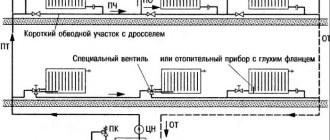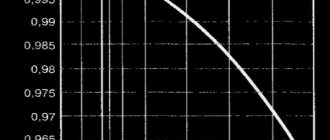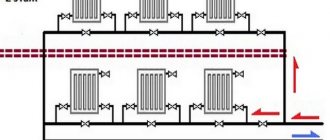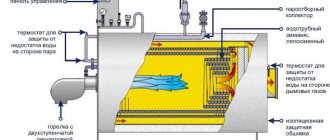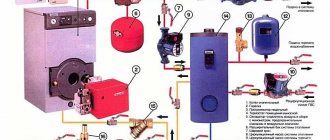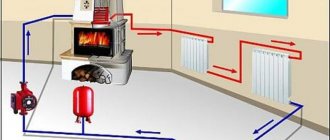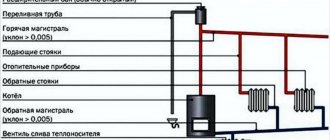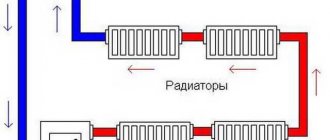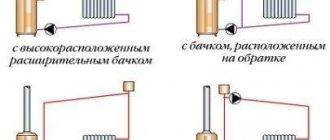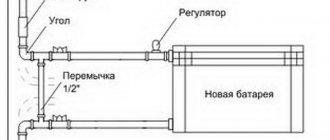Organization of pipe slope in the heating system
SNiP 2.04.05-86 in Appendix No. 10 gives instructions on the use of steam and water heating systems in industry and everyday life. Steam is used in production, water is used in housing. The steam heats heating appliances to temperatures above 100°C, which is dangerous for residents. This document does not apply to private households. The physics of steam heating processes consists of using dry steam, which, when condensed, releases a lot of heat. During the condensation process, 1 kg of steam releases 2300 kJ of thermal energy. Water cooled to 50°C gives 120 kJ.
Steam heating
The difference in energy output explains the advantages of steam heating:
- reduced number of radiators;
- quick system warm-up;
- lack of “defrosting” effect during breaks in work;
- noticeably lower heating costs during installation and operation.
The second and third points are important for dachas and country houses - buildings in which residents are visiting.
Based on the steam pressure used in the system, there are:
- High pressure systems (over 6 atm) - allow you to heat large areas with long pressure and condenser lines.
- Low pressure (1.7-6 atm) - possible use in private housing construction.
- Vacuum (pressure less than 1 atm) are interesting because they allow water to boil at temperatures below 100°C and reduce the temperature of heating devices to a safe level. They are used extremely rarely due to the need to ensure high tightness of the system.
A system communicating with the atmosphere is considered “open”; a system not communicating is considered “closed”.
The disadvantages of steam include:
- excessive heating of pipes and radiators;
- wear of system elements due to steam aggressiveness;
- noise accompanying the operation of the system.
During installation, one-pipe and two-pipe wiring diagrams are used. In the first case, steam and condensate move through one pipe. Steam comes from the boiler, condensate comes towards it. In a two-pipe system, steam flows through a pressure line to the radiators and, condensing in them, returns through a gravity condenser line in the form of water to a container for collecting it or directly to the boiler.
The slope when laying steam heating is taken to be 1-2% in the direction of movement of steam and condensate for two-pipe systems. The same 1-2% in the direction of condensate movement is taken for a single-pipe system.
How to calculate the required diameter of heating pipes
When calculating the diameter of a pipe for heating a living space, one more important parameter should be taken into account.
This is the thermal load. In accordance with the standards, comfortable living conditions in a room with a ceiling height of 2.5 m provide 0.1 kW of thermal power per 1 m2 of area. Therefore, you can very easily calculate how much heat is required to heat, for example, a room of 20 m2:
20 * 0.1 = 2.0 (kW).
In accordance with the table, the diameter of the pipes that can provide comfortable heat is selected. In our example, according to the table presented, in order to always keep the room warm, pipes with an internal diameter of 1/2 inch are quite suitable.
Thermal load and coolant flow for heating pipes of various diameters
Water heating
The popularity of water heating is explained by safety and greater comfort. There are systems with natural and forced circulation. In the first, the movement of the coolant occurs due to the difference in the specific gravity of hot and cold water, in the second, it is provided by a circulation pump. Single-pipe and two-pipe installation schemes are used.
With natural circulation, the slope is taken within 5-10 mm per linear meter of pipe. The slope in the heating system is arranged in the direction of water movement, i.e. the pressure line is inclined from the boiler to the radiators, and the return line is inclined from the radiators to the boiler. The water heating device must be located below the radiators, which may lead to the need to place the boiler in a pit. In a private home this does not create problems. If a slope when installing heating in an apartment leads to a similar result, it is necessary to increase the height of the radiators and reduce the slope of the pipes. It is necessary to decide what minimum slope in heating with natural circulation can be accepted without compromising performance. Practice suggests a value of 5 mm per linear meter. You can learn more about the regulatory requirements in SNiP 2.04.05.-91*.
Pumps are used to create water movement in complex systems. If the pump provides a flow rate of more than 0.25 m per second, there may be no pipe slopes. It is important that the air pockets move faster than the liquid and collect near the air valves located at the highest points of the system. During operation, repairs are possible that require draining the coolant. Therefore, it is advisable to slope the pipes in such a way as to ensure complete drainage of the coolant.
What minimum slope is accepted for water heating systems depends on the specific circumstances. It should not be less than 3 mm per 1 m. The angle of inclination of the single-pipe heating line is chosen based on the same considerations.
How to draw up a heating scheme correctly?
Heating boiler in the attic
When drawing up a wiring diagram for a heating system that has natural circulation, you need to take into account the design features and choose and buy the right components
- Main pipes. The optimal diameter for main pipes is 32 – 40mm. This will compensate for the friction of the coolant on their inner surface. The material that best meets this requirement is polymers. Polymer pipes are perfectly smooth, which ensures minimal friction.
- When drawing up a wiring diagram, you need to avoid as much as possible rotating elements that increase the hydraulic resistance in the heating system.
- The length of the accelerating riser must exceed the height of the last ceiling in the building, and the tank is generally installed in the attic.
- It is necessary to select the “correct” shut-off valves that will not affect the operation of the entire heating system with natural circulation.
IMPORTANT! To prevent changes in coolant flow, it is imperative to install a valve on the “return” side. This is especially important when starting a system with a small difference in water temperature.
Why is slope so important?
Heat supply systems with forced circulation and natural differ little from each other. The wiring, the materials used, heating radiators, all this can be identical, but the presence of a slope is a must!
Slope - the location of the supply pipeline in an inclined state from the accelerating riser to the heating radiators. The ratio of the lower and upper points of the riser should be 1 to 10, which means the deviation of each meter of pipe should be 1 cm. This is in relation to the supply pipe. For “return”, a slope in the opposite direction is applied. That is, from the heating radiators there is a slope towards the heating device (boiler). This makes it possible to create a gravitational effect on the water passing through the return line.
Advantages of a heating system based on natural circulation
Minimum set of equipment for this system
Most often, homeowners choose heating systems with natural circulation for the following reasons:
- Ease of installation, operation and maintenance of the system.
- There is no need to install additional equipment, which saves the homeowner’s finances.
- Energy saving. Even if there is no power supply to the boiler, the system will continue to function. This energy independence allows you to keep your home warm during frosts and lack of electricity.
- Maintainability. In cases of battery leakage or failure, the homeowner can easily troubleshoot without calling a professional.
- When the temperature decreases, the system self-regulates: the coolant flow increases.
- Possibility of self-installation of the system.
Characteristics of heating pipes
Pipes used in heating systems are divided into metal and plastic. The first include:
- steel;
- stainless steel;
- stainless steel corrugated;
- copper.
The listed materials are durable and have high performance properties, but are expensive and difficult to install. Their use is justified in steam heating systems.
Plastic pipes are:
- metal-plastic;
- polypropylene;
- made of cross-linked polyethylene.
Their common advantages include ease of installation, low weight, and reasonable price.
Gravity heating system with natural circulation - calculations, slopes, types
For private country houses and cottages, a heating system with natural coolant circulation is often installed. This decision has its positive and negative sides. The scheme is performed in four different ways.
A system with gravity circulation is sensitive to errors made during heating installation.
Features of a system of two parallel pipes
Two-pipe heating system
Houses and cottages that are of medium size, and the length of the main pipes exceeds 30 m, use a two-pipe system that separates the coolant - the cold and hot “branch”.
When installing a two-pipe system, remember that the boiler is mounted lower than the level of the batteries. Installing the boiler below the radiator level will provide sufficient cold water pressure to create natural circulation in the heating system.
When installing the system, it is necessary to provide for the presence of an accelerating riser, on which an expansion tank will be attached at the highest point. And a distribution pipe, mounted at an angle, will extend from it.
In order for a two-pipe natural circulation heating system to operate with a minimum temperature difference, the following factors must be taken into account:
- boiler location. It should be installed in a basement or basement, ensuring normal temperature, ventilation and lighting
- equip the expansion tank with a control pipe to replenish the system
- replenishment and drainage - units that allow you to control the process
The material for a two-pipe system is selected depending on preferences or financial capabilities.
IMPORTANT! When installing a two-pipe system, it is advisable to provide shut-off valves so that a separate radiator can be disconnected from the entire system.
The principle of operation of a natural circulation system
The heating scheme for a private house with natural circulation is popular due to the following advantages:
- Easy installation and maintenance.
No need to install additional equipment.
- Energy independence – no additional energy costs are required during operation. When the power goes out, the heating system continues to operate.
The operating principle of water heating, using gravity circulation, is based on physical laws. When heated, the density and weight of the liquid decreases, and when the liquid medium cools, the parameters return to their original state.
At the same time, there is practically no pressure in the heating system. In thermotechnical formulas, a ratio of 1 atm is accepted for every 10 m of water column pressure. Calculation of the heating system of a 2-story building will show that hydrostatic pressure does not exceed 1 atm, in one-story buildings 0.5-0.7 atm.
Since the liquid increases in volume when heated, an expansion tank is required for natural circulation. The water passing through the boiler water circuit heats up, which leads to an increase in volume. The expansion tank should be located on the coolant supply, at the very top of the heating system. The purpose of the buffer tank is to compensate for the increase in liquid volume.
A self-circulating heating system can be used in private homes, making the following connections possible:
Connection to heated floors - requires installing a circulation pump, only on a water circuit laid in the floor. The rest of the system will continue to operate with natural circulation. After a power outage, the room will continue to be heated using the installed radiators.
Recommendations for installation and assembly
After installation, you need to check the joints by pressure testing for leaks.
Starting installation, you should, in accordance with the existing heating system design, determine the location of the boiler, radiators, pumps, expansion tank, etc. Next, using a level, marks are applied to the walls indicating what slope the heating system should have in all its sections. When installing heating pipelines with forced circulation, slopes may not be required.
Testing the system after installation
After installation is completed, the quality of the work performed is visually checked. The main objective of the test is to identify leak locations. As a rule, the hydrostatic method is used. The system is filled with water and pressure is applied 25-50% higher than the working one. Stand for 1 hour. The total length of the test section should not exceed 100 m. Another method is a compressed air test. Before filling the heating system with coolant, compressed air is supplied to the system with a pressure 1-1.5 atm higher than the working one, and the pressure drop is monitored for 30 minutes. If there is no fall, the system is sealed. Otherwise, look for the leak. Determine the leak by washing.
Types of heating systems with gravity circulation
Despite the simple design of a water heating system with self-circulation of coolant, there are at least four popular installation schemes. The choice of wiring type depends on the characteristics of the building itself and the expected performance.
To determine which scheme will work, in each individual case it is necessary to perform a hydraulic calculation of the system, take into account the characteristics of the heating unit, calculate the diameter of the pipe, etc. You may need professional help when performing the calculations.
Closed system with gravity circulation
In EU countries, closed systems are the most popular among other solutions. In the Russian Federation, the scheme has not yet received widespread use. The operating principles of a closed-type water heating system with pumpless circulation are as follows:
- When heated, the coolant expands and water is displaced from the heating circuit.
Under pressure, the liquid enters a closed membrane expansion tank. The design of the container consists of a cavity divided by a membrane into two parts. One half of the tank is filled with gas (most models use nitrogen). The second part remains empty for filling with coolant.
Otherwise, closed-type systems work like other heating schemes with natural circulation. The disadvantages include the dependence on the volume of the expansion tank. For rooms with a large heated area, you will need to install a spacious container, which is not always advisable.
Calculation of resistance selection of the optimal pipe diameter
Having all the above data in hand, the selection of the section begins, often not in one approach. Having marked the gasket in accordance with the connection diagram, take a conventional cross-sectional size, for example 1 inch. After this, the system resistance is calculated and compared with the pressure created by gravity at the nominal heating value of the coolant and the cooled return temperature.
- If the pressure is not enough, then the cross section increases and the calculations are repeated.
- If the speed of water movement is too low or the volume of coolant is too large, then the cross-section is reduced and the calculation is repeated again.
Pipeline resistance is more easily expressed as head loss in meters of water column. A simple formula is used:
H = λ(Lк/Dт)(V2/2g),
where H is the nominal height equal to the resistance of the circuit, λ is the roughness coefficient, Lк is the length of the circuit, Dт is the internal diameter of the channel, V is the speed of fluid movement, g is the acceleration of gravity.
The formula contains all the key parameters, such as flow speed, pipe diameters in the heating system and their length. The difficulty arises with the coefficient λ (hydraulic friction), which can most easily be found from reference data for the type of pipe chosen as the main one for the design. Otherwise, a voluminous and complex calculation path will be required using the Reynolds Number, the formulas of Blasius and Konakov, Altschul and Nikuradze.
The task is to ensure that during natural circulation the resistance of the circuit is less than or equal to the pressure created by the difference in levels.
To decide which pipe size to choose for heating with natural circulation, you need to take the longest circuit from the boiler to the farthest radiator and compare the calculated pressure loss, provided that the pressure is the lowest. This means that when distributing routes in heating with natural circulation, all supply lines are located with a slight obligatory slope from the place closest to the boiler and to the farthest supply of the last radiator. The slope is approximately 1 cm per meter or at least 0.5%.
How to properly make water heating with natural circulation
All gravity systems have a common drawback - the lack of pressure in the system. Any violations during installation work, a large number of turns, non-compliance with slopes, immediately affect the performance of the water circuit.
To make proper heating without a pump, take into account the following:
- Minimum slope angle.
Type and diameter of pipes used for the water circuit.
What pipe slope is needed for gravity circulation
The design standards for an in-house heating system with gravity circulation are specified in detail in building codes. The requirements take into account that the movement of liquid inside the water circuit will be hampered by hydraulic resistance, obstacles in the form of corners and turns, etc.
The slope of heating pipes is regulated by SNiP. According to the standards specified in the document, a slope of 10 mm is required for each linear meter. Compliance with this condition guarantees unhindered movement of fluid in the water circuit.
Violation of the slope when laying pipes leads to airing of the system, insufficient heating of radiators remote from the boiler, and, as a result, a decrease in thermal efficiency.
What pipes are used for installation
The choice of pipes for the manufacture of the heating circuit is important. Each material has its own thermal characteristics, hydraulic resistance, etc. When performing installation work yourself, additionally take into account the complexity of installation.
The most commonly used building materials are:
- Steel pipes - the advantages of the material include: affordable cost, resistance to high pressure, thermal conductivity and strength. The disadvantage of steel is its complex installation, which is impossible without the use of welding equipment.
Metal-plastic pipes - have a smooth inner surface that prevents the circuit from clogging, light weight and linear expansion, no corrosion. The popularity of metal-plastic pipes is somewhat limited by their short service life (15 years) and the high cost of the material.
Polypropylene pipes are widely used due to their ease of installation, high tightness and strength, long service life and resistance to freezing. Polypropylene pipes are installed using a soldering iron. Service life of at least 25 years.
